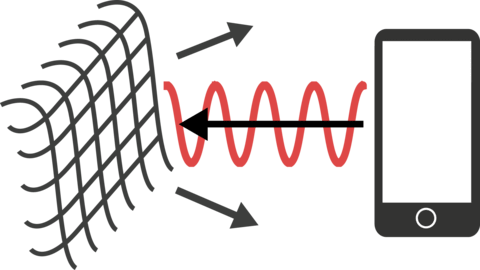The WaveWall Blog
Do EMF Protection Devices Work?
Do EMF protection devices work? It would be easy for us just to say “Yes.” Okay, you are thinking, but how do EMF protection devices work?
If you are wondering whether EMF protection devices work, or more to the point, how EMF protection devices work, let’s find out.
It’s all based on an old, well known scientific principle: the Faraday cage. It’s a metallic enclosure that prevents electricity or electrical impulses – like mobile phone radiation which uses an electromagnetic field – from travelling in or out.
How do EMF Protection Devices Work?
The Faraday cage is named after the British scientist Michael Faraday, who discovered how it worked in the late 1800s. It’s a technology that is used a lot, but we don’t always realise it. How Stuff Works has an entertaining and informative article on the Faraday cage, tracing its history, the science and its uses. Essentially, the Faraday cage disrupts, absorbs and disperses incoming radiation.

Some cinemas deploy building-wide technology that is in effect a Faraday cage. This is to stop you from receiving a mobile phone signal. Or you might have to seal your phone in a Faraday sleeve – the same idea, but more an envelope than a cage – if you are attending a top-secret event. Attendees at a recent Star Wars premiere had to do this to prevent any subversive audio or video recording.
This bar owner built a Faraday cage around their bar to prevent patrons from using their phones, encouraging real conversation!
This device was built to stop smartphone addiction, and can hold 7 smartphones! It also uses a Faraday cage.
Faraday sleeves are becoming popular to stop electronic car keys from being hacked. They can also effectively cloak your phone’s GPS signal and obscure your whereabouts. Conspiracy theorists might make a DIY Faraday cage to protect their electrical devices in case of World War III or an EMP attack. Suppose you’ve heard of the phrase ‘tinfoil hat’? Yep, this is based around the concept of a Faraday cage!
In fact, if you wrap your phone in aluminium foil, it will in effect block most signals coming in and out. You can try this at home.
WaveWall and the Faraday Cage
As you can see, the Faraday cage is an extremely effective tried-and-tested concept. There is absolutely no pseudoscience here. You can even prove that it works by wrapping a phone in foil and trying to call it – it won’t work if you use enough.
Of course, wrapping and unwrapping your phone in foil is an absolutely surefire way to look like quite the loon in public, even if your intentions are actually very sensible and sound. We have numerous resources here at WaveWall that describe the science behind why we should be protecting ourselves from phone radiation.
That is where WaveWall come in!
WaveWall cases pack the superb tried-and-tested science of the Faraday cage into stylish and usable cases and laptop shields.
Also, WaveWall cases aren’t a full cage. They are open on one side, which means that your phone, iPad or laptop can still connect to the network or WiFi and work normally. The side nearest your body is shielded and the radiation bounces right off. What it bounces off is the finely woven metallic mesh in the fabric – the Faraday cage.
This works because phone radiation is very directional and it won’t ‘wrap’ around the case. Phone radiation travelling towards your body will be disrupted by the phone case, whereas radiation travelling away from your body is ultimately harmless.
So, do EMF protection devices work? Absolutely, and WaveWall uses patent pending EMF protection technology for our range of EMF protection devices. Independent testing has shown it blocks up to 87% of mobile phone radiation.

